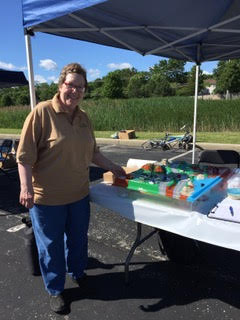 Rosemary at the Buffalo Grove Green Fair last summer, demonstrating our Enviroscape watershed model. Rosemary at the Buffalo Grove Green Fair last summer, demonstrating our Enviroscape watershed model. Thanks and congratulations to Rosemary Heilemann, our 2018 Palleon Award Winner. Rosemary is a member of the League of Women Voters Deerfield/Lincolnshire (IL) and also the League of Women Voters of Lake County (IL). She is an active volunteer with us and other Leagues, as well as outside groups such as the Sierra Club. Water protection is a frequent goal of her education and advocacy efforts. The Palleon Award was established in honor of past board member Art Palleon, who was a proponent of vigorous advocacy efforts. It was awarded to Rosemary at our 2017 Annual Meeting in Green Bay, Wisconsin. Rosemary is the first off-board recipient of the Palleon Award. On July 3rd, show your support for our Great Lakes, and water protection more generally. Like-minded people all around the lakes will SHOW UP to make their support visible by attending events at 10 am (Eastern Time) to join hands and pass a marble.
Events are already planned in many locations, but if there isn't an event near you, you are invited to organize one. This would be a terrific, quick project for a local League! All the information, including locations, is available from All Hands on Deck. The Great Lakes are a global hub of oil refining. There are many pipelines traversing the state of Michigan. In 2010, a pipeline (6B) owned by Enbridge discharged over 1 million gallons into the Kalamazoo River. A series of dams prevented it from reaching Lake Michigan, but the damage was extensive.This was the warning that awoke Michigan’s concerns. Enbridge made the largest settlement for the largest inland “spill”. It must be told that not all the oil was removed. Because this was a heavy tar sands oil, it dropped to the bottom of the river, trapped in sediment. After extensive dredging, it was determined that to do anymore, would cause great harm to the river’s ecosystem. Lessons learned from this accident demonstrated that Enbridge’s claims that they employ technology designed to detect and shut down the oil flow, should such an event occur, is not true.The Kalamazoo River oil discharge went on for 17 hours before residents reported the leak. The 2010 Kalamazoo River discharge prompted a National Wildlife Federation review of existing pipelines in Michigan. One pipeline was highlighted because of it’s age and location. Pipeline 5 travels from Wisconsin, through the Upper Peninsula of Michigan, under the Straights of Mackinac through the Lower Peninsula and exits at a refinery in Sarnia, Ontario. It is estimated that only 5-10% of this oil is used by Michigan. The rest is shipped, with a great deal going to Great Britain. The pipeline portion under the Straights of Mackinac become a set of twin pipelines running 5 miles. They are 64 years old and carry over 500,000 barrels of light crude oil and natural gas per day. The transport of liquified natural gas through pipeline, as occurs here, is unusual. About half of this natural gas is used to heat rural, upper Michigan homes. These needs can be addressed by other transportation modes such as rail and truck. It would take 4-5 tanker trucks or 1-2 rail cars daily. A 2014 study by the University of Michigan found that the Straights of Mackinac are the “worst possible place” for an oil spill in the Great Lakes. The shifting currents where Lake Michigan and Lake Huron meet are 10X the force of Niagara Falls. An easement agreement with the State of Michigan requires support bracing every 75 feet. Enbridge has been out of compliance many times and frequently needs to apply for permits to add the required anchors. The strong, shifting currents create an unstable bottomland. Response to a clean-up incident during the winter when the Straights are frozen, would be impossible. The harsh currents at this location would make containment unmanageable. Anti-corrosive coatings are missing in 19 areas. Enbridge’s response to State of Michigan requests for inspection information has been difficult. As a lobby group they proposed legislation to protect themselves from FOIA requests due to national security concerns. Regulation of pipelines is done by the federal government. But the State of Michigan has responsibility for this portion of the bottomlands of the Great Lakes through the Public Trust Doctrine. All other pipeline disputes involve installation of new pipeline. This is the first challenge to an existing pipeline. The Governor established a Michigan Pipeline Advisory Board in 2015. Two studies were commissioned. An alternatives analysis will evaluate alternative routes or complete replacement of the pipeline. The risk analysis study will establish adequate financial assurance should a discharge occur. These studies are being conducted by private contractors, hired by Enbridge. They are due the end of June. Enbridge will have the opportunity to review, before it is submitted to the state. The contractors will present the draft on July 6, 2017, when public comment will begin. Public hearings will be held on July 24-25. After the public comment period concludes, the state will prepare their recommendations with a final draft in the Fall. Information on the pipeline and comment process can be found at: www.oilandwaterdontmix.org LWVMI has joined the Oil and Water Don’t Mix Coalition and is on the steering committee. We support the decommissioning of Pipeline 5. We support Senator Rick Jones’(R) and Senator Steve Bieda’s (D), SB 292.
LWVMI supports House Resolution 0051 (2017) urging the Governor and Attorney General to exercise their authority, immediately, to terminate the 1953 easement and shut down Enbridge Line 5 under the Straights of Mackinac. This has been referred to the House Policy Committee. Both Senators Stabenow and Peters introduced a package of bills that would increase pipeline safety in and around the Great Lakes and account for the unique needs of the Great Lakes ecosystem. The bills would:
This proposal builds on a previous bill they passed in 2015, which was signed by President Obama. The Protecting Our Infrastructure of Pipelines and Enhancing Safety Act, or PIPES Act. This Act strengthened pipeline oversight and improves response plans for oil spills under ice-covered waters. Thanks to Suzanne Dixon, a representative to the LWVLMR Board from Michigan, for submitting this article. Clinton and Trump Campaigns Pledge Ongoing Support for the Great Lakes Restoration Initiative9/28/2016
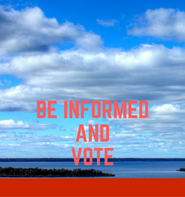 The Healing Our Waters--Great Lakes Coalition invited both major party Presidential candidates to speak at its annual restoration conference held last week in Sandusky, OH. Representatives from both campaigns attended, gave statements and answered several questions moderated by Todd Ambs, coalition campaign director. Great news: both pledged to continue support for the Great Lakes Restoration Initiative (GLRI), if elected! LWVLMR encourages all voters to be informed about where the candidates stand on Great Lakes issues. Healing Our Waters has posted videos from the forum on Facebook. Watch and determine which best represents your views on the importance of and emphasis on the lakes: Trump campaign representative, Mike Budzik, past chief, Ohio Division of Wildlife under Ohio Gov. Bob Taft, and Clinton campaign representative David Hayes, former deputy secretary, Department of Interior in the Obama Administration. LWVLMR has advocated for federal funding of the GLRI with the Coalition since the start of the program. The GLRI has brought $2.2 billion of restoration projects to the Great Lakes over the last seven years, but much work is still needed to improve the health of the lakes.  #goals #goals Charlotte Adelman, one of the leaders of our upcoming (sold-out!) tour of native plant gardens in Wilmette, Illinois, is an expert on native plants. So which books on native plants has she found useful? She was kind enough to share her favorites with us. Whether you are taking the tour or not, check out the following books to learn about native plants' many environmental benefits and gain insights into how to incorporate them into your own garden:
Charlotte herself is the author of The Midwestern Native Garden: Native Alternatives to Nonnative Flowers and Plants and the forthcoming Midwestern Native Shrubs & Trees: Gardening Alternatives to Nonnative Species. We are lucky and pleased to be able to share her expertise with our members and others who care about the Lake Michigan ecosystem! 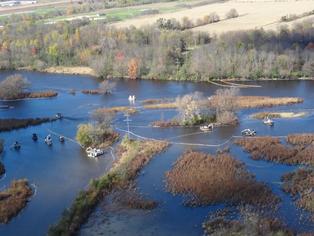 2011 clean up work of the Enbridge oil spill (credit: www.michigan.gov at http://bit.ly/29VG65p) 2011 clean up work of the Enbridge oil spill (credit: www.michigan.gov at http://bit.ly/29VG65p) The LWV Lake Michigan Region Annual Meeting in Douglas, Michigan back in 2011 included a paddleboat cruise on the Kalamazoo River, narrated by LWVMI delegate Suzanne Dixon. Instead of talking about the natural beauty or a thriving local ecosystem, our group learned about the environmental disaster caused by the oil spill from an Embridge pipe leak. Today, the U.S. EPA and the Dept. of Justice today announced a settlement with Enbridge Energy Limited Partnership (and several related companies) to resolve claims stemming from its 2010 oil spills in Marshall, MI and Romeoville, IL. Enbridge has agreed to spend at least $110 million on measures to prevent spills and improve operations across nearly 2,000 miles of its pipeline system in the Great Lakes region. These measures include:
Enbridge will also pay civil penalties totaling $62 million for Clean Water Act violations. Enbridge has already reimbursed the government for $57.8 million in cleanup costs from the Marshall spill and $650,000 for cleanup costs from the Romeoville spill, and Enbridge reportedly incurred costs in excess of $1 billion for required cleanup activities for these spills. “This was one of the largest inland oil spills in U.S. history when Enbridge discharged one million gallons of oil to Talmadge Creek near Marshall,” said acting EPA Regional Administrator Robert Kaplan. “Together with our state and local emergency responders, EPA was able to contain the spill before it reached the Great Lakes. After 22 months of arduous cleanup work, the Kalamazoo River finally reopened for recreational activities.” The government’s complaint alleges that on July 25, 2010, Enbridge's 30 inch-pipeline known as Line 6B discharged at least 20,082 barrels of crude oil, much of which entered Talmadge Creek and flowed into the Kalamazoo River which flows to Lake Michigan. Flooding caused by heavy rains pushed the discharged oil over the river's banks into its flood plains, and accelerated its migration over 35 miles downstream before it was contained. Line 6B, which originates in Griffith, IN, crosses the lower peninsula of Michigan and ends in Sarnia, Canada, has since been replaced with a new, larger pipeline, also known as Line 6B. The complaint also alleges that on September 9, 2010, another Enbridge pipeline, known as Line 6A, discharged at least 6,427 barrels of oil in Romeoville, IL, much of which flowed through a drainage ditch into a retention pond in Romeoville. There will be a 30 day public comment period on the consent decree. Information on how to comment will be available in the Federal Register and on the Department of Justice’s website: www.justice.gov/enrd/consent-decrees. More info on the settlement is available at https://www.epa.gov/enforcement/enbridge-clean-water-act-settlement  Yes, you have unwanted/unneeded/expired drugs. Keep them out of our waters! Yes, you have unwanted/unneeded/expired drugs. Keep them out of our waters! If you are like us, April means its Drug Take Back time, and you are in the habit of going through your prescription and over-the-counter drug containers to weed out the expired and unneeded drugs. That is still a good idea, but this year you may have to rethink where you will bring the drugs for safe disposal so they stay out of our freshwater sources. After organizing highly successful National Drug Take Back Days in April and October of the last four years, the Drug Enforcement Agency (DEA) has discontinued the program. Ongoing local collection sites are now available thanks to the Secure and Responsible Drug Disposal Act of 2010. To find a drug collection site near you, search the DEA's database, or find a site run by Yellow Jug Old Drugs®, a collection program operated by the Great Lakes Clean Water Organization in Wisconsin, Illinois, Indiana, Michigan and Ohio. 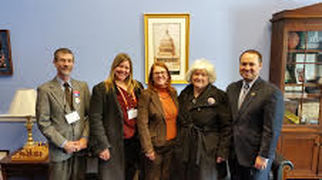 Bruce Allen & Abigail King from Save Maumee, Debbie Chubb & Jeanette Neagu, LWV of Indiana, and Rep. Marlin Stutzman (IN-3). Feb. 26, 2015 Bruce Allen & Abigail King from Save Maumee, Debbie Chubb & Jeanette Neagu, LWV of Indiana, and Rep. Marlin Stutzman (IN-3). Feb. 26, 2015 I have just returned from Washington, D.C. where Debbie Chub and I represented League of Women Voters of Indiana at Great Lakes Day. This is an annual event where citizen lobbyists from throughout the country come to address the need for continuation of federally funded programs to protect the Great Lakes from pollution and to restore the Areas of Concern, and discuss other important concerns about the health of the Great Lakes. LWVIN is a member of Healing our Waters, the Coalition that organizes Great Lakes Day. The Indiana team was able to meet with Representatives Stutzman and Walorski as well as staff from the offices of Representatives Carson, Visclosky, Donnelly and Coats. The other Indiana Representatives did not respond to meeting requests. The first day we were updated on all the marvelous projects that have been completed because of Great Lakes Restoration Funding. Please take a look at the Great Lakes, Great Impact website from the Joyce Foundation which gives you more information about the Great Lakes Restoration Initiative (GLRI). We would appreciate any efforts you can make to gain your legislator’s support for $300 million federal dollars to continue the work of restoring the Great Lakes. Healing Our Waters has put out an action alert with valuable information about how individuals can help. Debbie and I were also able to attend a most informative hearing called by Representative John Conyers (MI-3) and the Unitarian Universalist Service Committee on how federal, state and local agencies can work together to ensure universal access to quality drinking water. The hearing was supported by Representatives Charlie Rangel (NY-13), Earl Blumenauer (OR-3), Brenda Lawrence (MI-14), Debbie Dingell (MI-12), and Sheila Jackson Lee (TX-18). This link describes the problem addressed: http://www.huffingtonpost.com/john-conyers/drinking-water-a-human-ri_b_6754308.html Representative Stutzman is a farmer and was most amenable to our suggestions on the necessity of reducing nutrient outflows from farm lands into our waterways. We expected to spend fifteen minutes with a staff member and instead spent forty minutes with him. The trip was very valuable. Jeanette Neagu, Chair Natural Resources Committee LWV of Indiana
The delegation also adopted a resolution honoring Vice President Janet Greenwald, absent due to illness, and the longest serving board member. Indiana delegate Jeanette Neagu shared a gift that will be presented to Janet along with a signed copy of the resolution.
Finally, several advocacy opportunities were offered to local Leagues and individuals, then the meeting adjourned to a reception at the "Top of the Park." 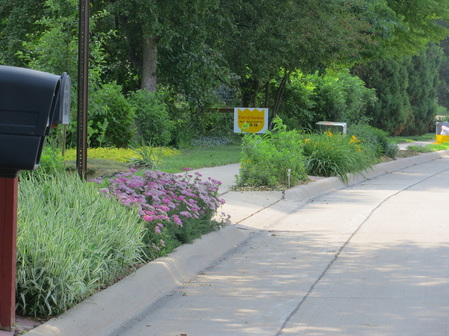 Native plants make for a lovely parkway planting at the Cheevers' Native plants make for a lovely parkway planting at the Cheevers' As we've been on the road, promoting the use of green infrastructure for all of its virtues, including its ability to naturally clean stormwater, we've heard plenty of stories. This one comes from Jean & Doug Cheever, of the League of Women Voters of Dubuque, IA. They shared, Our street is a major arterial that is salted and plowed frequently in winter. The strip between the sidewalk and street faces southwest. This "hell strip" gets hot during summer afternoons and, in winter, is regularly exposed to salt and repeated freezing and thawing. The sod installed after construction quickly became weedy and patchy and required more work than the rest of our lawn. We finally gave up and replaced grass with suggested salt-, drought-, and ice-resistant plants. 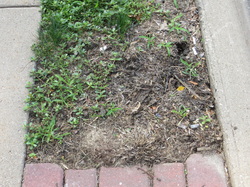 The "Hell Strip"--before The "Hell Strip"--before It turned out that the City only allowed grass in parkway plantings. After some research, the Cheevers found a St. Paul, Minnesota ordinance that encouraged other street plantings as long as they were less than 3 feet tall and did not include noxious weeds or marijuana. Armed with their case and the ordinance, they appealed to their government officials. Success! The City changed the policy! Thanks, Cheevers, for helping to beautify America and working towards cleaner water! |
Archives
December 2017
Categories
All
|

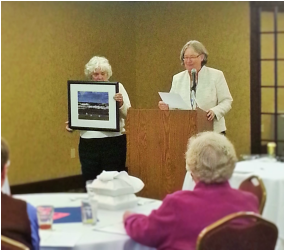
 RSS Feed
RSS Feed